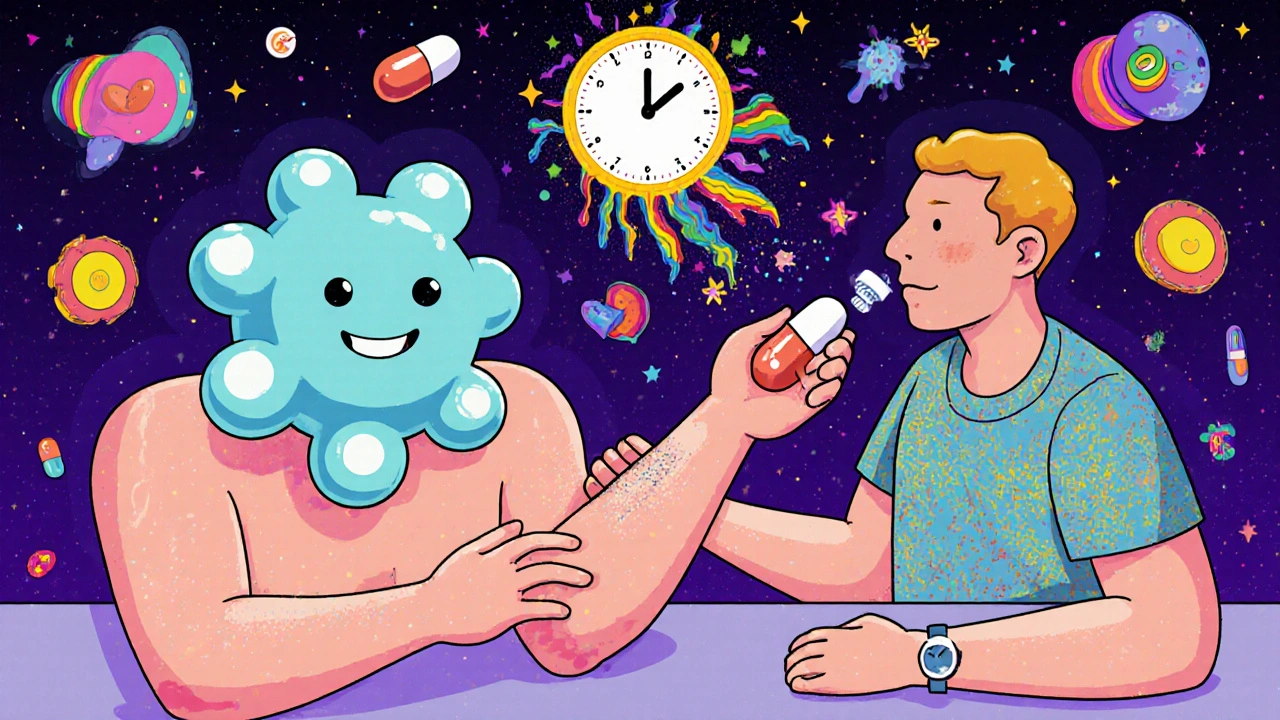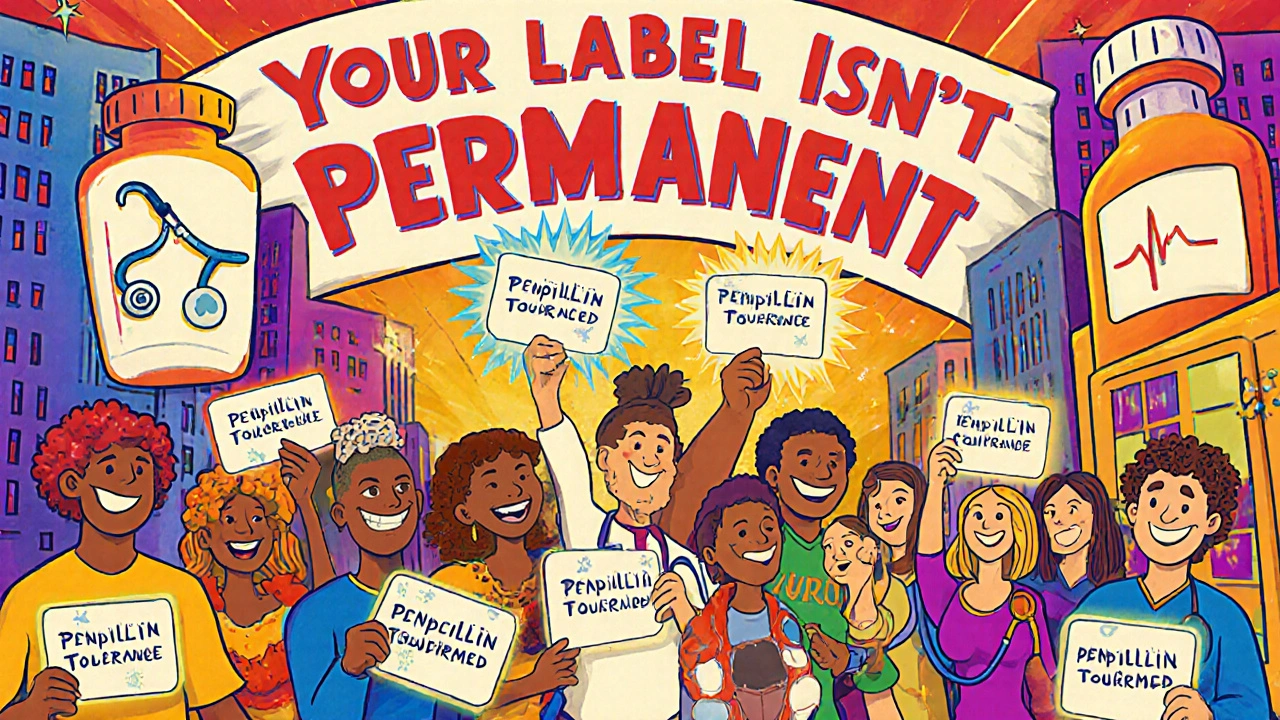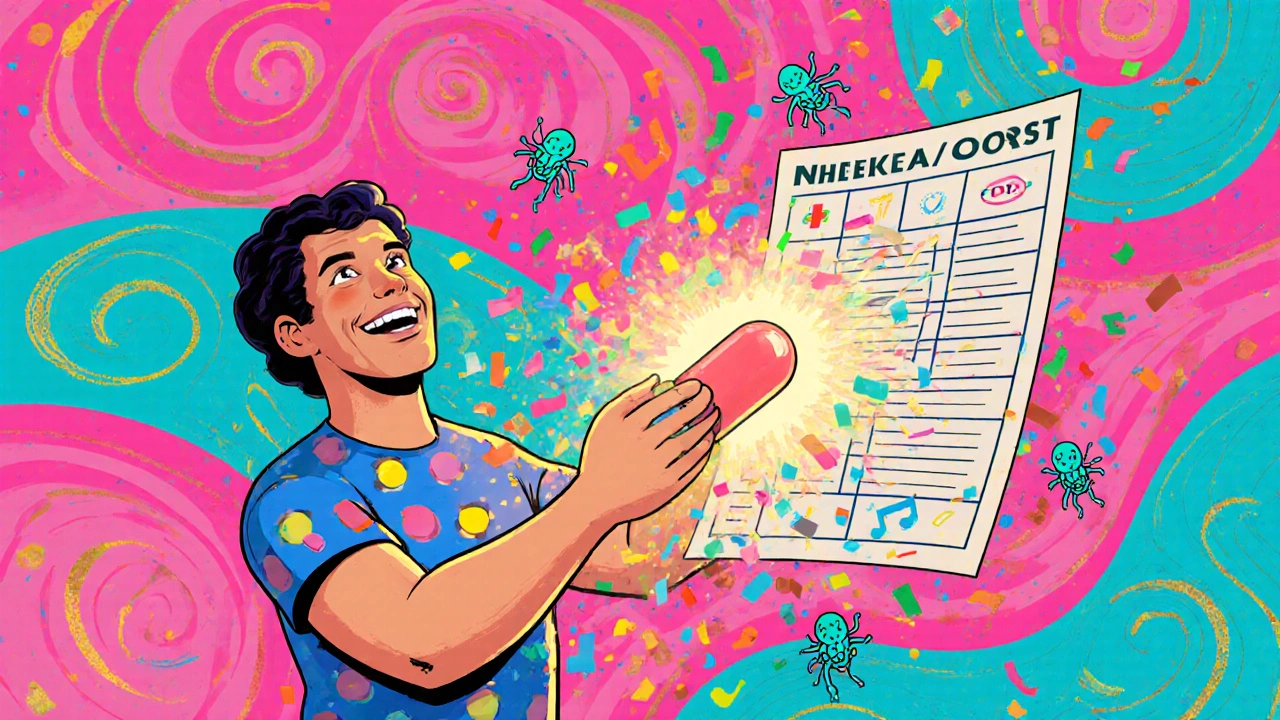More than 95% of people who think they’re allergic to penicillin aren’t. That’s not a guess. It’s what medical studies show-over and over again. You might have been told you’re allergic after a rash as a kid, or maybe a nurse wrote it down during a hospital visit years ago. Now, every time you get sick, your doctor avoids penicillin and reaches for something stronger, costlier, and riskier. But here’s the truth: that label might be wrong. And fixing it could change everything.
Why Your Penicillin Allergy Label Might Be Wrong
Penicillin and related antibiotics like amoxicillin are among the safest, most effective drugs we have. They work well for common infections-ear infections, sinus infections, strep throat, urinary tract infections. But if you’re labeled allergic, your doctor can’t use them. Instead, they’ll prescribe alternatives like azithromycin (Z-Pak), clindamycin, or fluoroquinolones. These drugs aren’t just more expensive. They’re less targeted. They kill more good bacteria. And they increase your risk of dangerous infections like C. diff, which causes severe diarrhea and can be life-threatening. The CDC estimates that false penicillin allergy labels lead to about 50,000 extra cases of C. diff every year in the U.S. alone. That’s not just a statistic. That’s people in hospitals, in pain, recovering slowly because of a label that probably shouldn’t exist. And here’s the kicker: true penicillin allergy is rare. Only 1-2% of people who report it actually have a real IgE-mediated reaction-meaning their immune system truly overreacts. The rest? They had a rash that was viral, not allergic. They got nausea from the pill. Or they were told they were allergic because someone else in the family was. Over time, that label sticks. And no one checks.What Happens When You Get Tested
Getting tested isn’t complicated. It’s not scary. And it’s not painful. For most people, it’s a simple three-step process:- History review. Your doctor asks about your reaction-when it happened, what it looked like, how long it lasted. A tool called PEN-FAST helps them decide if you’re low risk. If your reaction was just a rash more than 10 years ago, with no breathing problems or swelling, your chance of being truly allergic is less than 5%.
- Skin test. A tiny drop of penicillin is placed on your skin, then gently pricked. If you’re not allergic, nothing happens. If you are, a red, itchy bump appears within 15-20 minutes. This test is safe, quick, and nearly 100% accurate at ruling out true allergies.
- Oral challenge. If the skin test is negative, you’ll swallow a small dose of penicillin-usually amoxicillin-under observation. You’ll wait 60-90 minutes. If you feel fine, you’re cleared. No more allergy label.
Why Doctors Don’t Always Test You
If it’s this safe and this effective, why aren’t more people getting tested? The answer isn’t medical. It’s systemic. Most doctors aren’t trained in allergy testing. They don’t have the tools. Hospitals don’t always stock the right penicillin formulations for testing. Electronic health records make it hard to update allergy status once it’s entered. And many patients are afraid. They’ve lived with the label for decades. They think, “What if I react this time?” Even worse, in rural areas, there might be only one allergist for every 500,000 people. That means access is nearly impossible for many. But change is happening. In 2021, Epic Systems-a major electronic health record company-added an automated penicillin allergy assessment tool. Since then, over 227,000 assessments have been done, and nearly 90% of those labels were removed because they were wrong. Some hospitals now have “penicillin allergy clinics” run by pharmacists or nurses trained in de-labeling. At the University of Pennsylvania, they’ve successfully de-labeled over 1,800 patients since 2020-with zero severe reactions.
What You Can Do Right Now
You don’t need to wait for your doctor to bring it up. You can start the conversation today. Ask yourself:- When was the reaction? Was it more than 10 years ago?
- Did you have swelling, trouble breathing, or dizziness? Or just a rash?
- Have you ever taken penicillin since then without a problem?
- Have you ever been told you’re allergic, but never tested?
The Real Cost of Keeping the Label
Let’s talk money. The average patient with a false penicillin allergy label spends about $1,000 more per year on healthcare than someone without it. Why? Because they get more expensive antibiotics. They’re more likely to be hospitalized. They’re more likely to get C. diff. They’re more likely to need longer treatments. One case from Massachusetts General Hospital tells the whole story: a 68-year-old man had a 40-year-old penicillin label. He kept getting urinary tract infections. Each time, he got a broad-spectrum antibiotic. He ended up in the hospital three times over two years. After testing and de-labeling, he was given amoxicillin for his next infection. No hospital stay. No IV drugs. No extra cost. Just a simple pill. He saved over $28,500 in two years. And it’s not just about you. When we overuse broad-spectrum antibiotics, we all pay the price. Antibiotic resistance rises. Superbugs spread. Treatments stop working. That’s not a future threat. It’s happening now.
What Happens After You’re De-Labelled
Once you’re cleared, your allergy record gets updated. Not just “penicillin allergy” removed-but replaced with “penicillin tolerance confirmed.” That matters because different penicillins aren’t all the same. Amoxicillin, ampicillin, and penicillin V can be tolerated even if you’re allergic to one. Your doctor will update your chart. Your pharmacy will be notified. You’ll get a letter or card you can keep in your wallet. And next time you’re sick, you’ll have more options. Faster recovery. Fewer side effects. Lower cost. One Reddit user wrote: “After being told I was allergic since age 5, I did the test at Mayo Clinic. Now I take amoxicillin for sinus infections instead of Z-Pak-which always gave me stomach issues. I wish I’d done this 20 years ago.”What If You Test Positive?
If you do have a true allergy, that’s okay. Knowing for sure is better than guessing. You’ll avoid the drug, yes-but you’ll also know exactly what to avoid. You won’t be told you’re allergic to “all antibiotics.” You’ll know it’s just penicillin. And you might still be able to take other beta-lactams like cephalosporins, depending on your reaction history. You’ll also get an epinephrine auto-injector if needed, and a medical alert bracelet. You’ll be prepared. And you’ll never have to wonder again.Final Thought: Your Label Isn’t Permanent
Allergy labels aren’t tattoos. They’re not forever. They’re notes in a chart. And if they’re wrong, they can-and should-be fixed. You didn’t ask to be labeled allergic. You were told. Maybe you didn’t understand. Maybe no one asked the right questions. But now you know. And now you have power. Getting tested isn’t just about saving money or avoiding side effects. It’s about taking control of your health. It’s about making sure your next infection is treated with the best medicine-not the safest one for doctors who don’t know better. Don’t wait for someone else to fix it. Ask. Get tested. Be free.Can I outgrow a penicillin allergy?
Yes. Most people who think they’re allergic to penicillin never had a true allergy to begin with. Even if you did have one as a child, the immune system often forgets it over time. Studies show that up to 80% of people who were truly allergic as kids lose the allergy after 10 years. Testing is the only way to know for sure.
Is penicillin allergy testing safe?
Extremely safe when done properly. Skin testing has a near-zero risk of serious reaction. Oral challenges are done under supervision with emergency equipment on hand. In large studies, fewer than 2% of patients have any reaction-and most are mild, like a small rash. Severe reactions are extremely rare.
Do I need to see an allergist?
Not always. Many primary care doctors, pharmacists, and infectious disease specialists are now trained to perform low-risk de-labeling using direct oral challenges. If you’re low-risk (based on your history), you may not need an allergist at all. High-risk cases-like past anaphylaxis-still require specialist care.
How long does the testing take?
The whole process usually takes 2-3 hours. Skin testing takes about 30 minutes. The oral challenge takes another 60-90 minutes of observation. Most people go home the same day. Some clinics offer split visits-skin test one day, oral challenge the next.
Will my insurance cover the test?
In most cases, yes. Medicare, Medicaid, and private insurers in the U.S. cover allergy testing for penicillin when medically necessary. In Australia, Medicare rebates apply for allergy assessments done by accredited specialists. Always check with your provider, but the cost is usually far less than the price of unnecessary antibiotics and hospital stays.
What if I’m allergic to something else, like sulfa or cephalosporins?
Penicillin allergy testing doesn’t cover other drugs. But if you’re labeled allergic to multiple antibiotics, it’s even more important to get tested. Many people confuse side effects (like nausea or diarrhea) with allergies. A clear history and testing can help untangle which drugs are truly risky-and which ones you can safely use.


vanessa k
November 12, 2025 AT 05:42I never thought about this until my mom got hospitalized for C. diff after being given clindamycin for a UTI. She had a rash at 8 and was labeled allergic forever. Turns out she was never allergic. They gave her amoxicillin after testing and she was fine. No more hospital trips. Why isn't this standard practice everywhere? It's not just about money-it's about not poisoning people with unnecessary antibiotics.
Eve Miller
November 13, 2025 AT 15:48It’s statistically irresponsible to claim that 95% of penicillin allergy labels are false without clarifying that this figure applies only to low-risk historical reports. The CDC data cited conflates self-reported histories with confirmed IgE-mediated reactions, which is methodologically flawed. Furthermore, the term ‘false’ implies deception, when in reality, many patients experienced real, albeit non-IgE, adverse reactions. Precision in language matters-especially in medicine.
Chrisna Bronkhorst
November 13, 2025 AT 15:50Let’s be real-doctors don’t test because it’s not profitable. Antibiotics are big business. Z-Paks and IV drugs bring in more revenue than a $5 amoxicillin pill. Hospitals don’t care about your long-term health-they care about billing codes. And don’t get me started on EHRs that lock in allergies like gospel. The system is broken. Testing saves lives but loses money. That’s why it’s rare.
Amie Wilde
November 14, 2025 AT 22:15I got tested last year. Skin prick was fine. Swallowed the pill. No reaction. My chart says ‘tolerance confirmed’ now. Took 2 hours. Best decision I ever made. No more stomach issues from Z-Pak. Simple.
Gary Hattis
November 15, 2025 AT 21:00I’m from a rural town in Nebraska. Our clinic doesn’t have an allergist within 150 miles. I asked about testing three times. Each time they said ‘we don’t do that here.’ So I got a referral to a pharmacy in Omaha that does oral challenges. Took three weeks to get in. Paid $120 out of pocket. Got cleared. Now I take penicillin for every infection. My doctor still won’t update my record. The system is designed to keep you stuck. Don’t wait for them to help you-go find someone who will.
Esperanza Decor
November 16, 2025 AT 07:31This is the kind of thing that changes everything. I’ve been telling my friends for months about this. My cousin was told she was allergic after a rash at 6-now she’s 32 and gets every infection treated with vancomycin. She’s had three C. diff episodes. We finally convinced her to get tested. She’s cleared. She cried. Not because she was scared-but because she realized she’d been living with a lie for 26 years. We need to spread this like wildfire.
Deepa Lakshminarasimhan
November 17, 2025 AT 09:23Wait. Who benefits from keeping these labels? Big Pharma? The hospitals? The EHR companies? This feels too clean. Like they’re pushing this so we stop questioning why antibiotics are so expensive. What if the real allergy is to corporate greed? What if the ‘testing’ is just a way to make us pay more for a procedure that should be free? I’m not trusting this yet. Who funded these studies?
Erica Cruz
November 17, 2025 AT 15:12Wow. Another feel-good article from someone who clearly has never had to manage a real allergic reaction. You’re romanticizing a process that carries risk-even if rare. And you act like everyone has access to a ‘penicillin allergy clinic’ like it’s a Starbucks. Most people don’t even have primary care. This isn’t empowerment-it’s privilege porn wrapped in medical jargon. Stop pretending this is a simple fix for everyone.